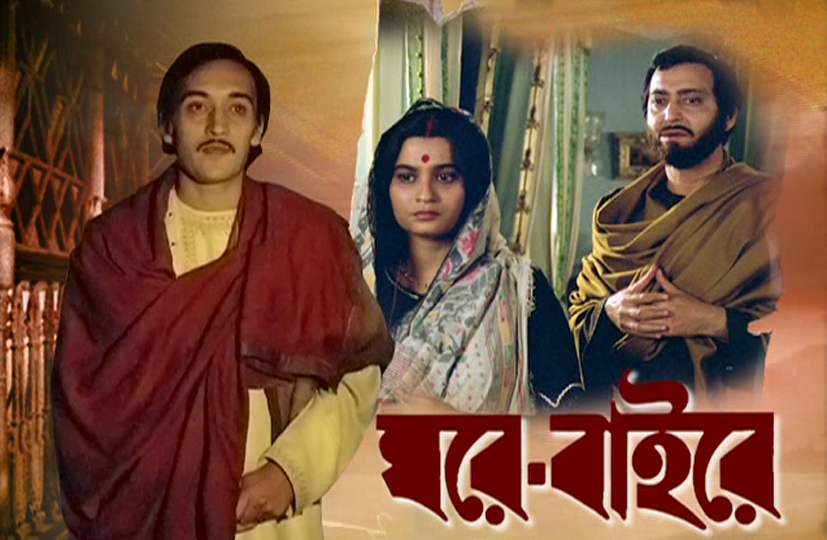From Devi to Charulata, Satyajit Ray’s portrayal of Indian women is known to be real, articulate and masterful. But in the later stage of his career, he created Ghare-Baire (The Home and The World) (1984) that spoke volumes about the relation between the nationalist movement and Indian women. Based on the novel by Rabindranath Tagore (1919) with the same title, the film effectively recreates the era of the Swadeshi movement and the dichotomy experienced by women as part of the reforms.
“When it comes to truthfulness about women’s lives, this great Indian moviemaker Satyajit Ray shames the American and European directors of both sexes,” Pauline Kael, celebrated film critic from the New Yorker
Before understanding the characters in the film from a gendered perspective, it is important to understand it’s context. Set in the early 20th century, marking the emergence of nationalism and the spread of the Swadeshi movement amongst masses, especially in Bengal. This movement gave Indians the chant of Vande Mataram and impacted the country’s political discourse.
Set at this backdrop, Ghare-Baire tells a story of Bimala (Swatilekha Chatterjee), who is married to Nikhil (Victor Banerjee), a wealthy but liberal Zamindaar (Land-Owner). Bimala is an ideal housewife who has never set a foot outside a certain section of her home after marriage. Her husband Nikhil, understands the nuances of the Swadeshi movement but does not completely support it. He is constantly provoked by Sandip (Soumitra Chatterjee), his friend and the fierce leader of the Swadeshi movement.
In the beginning of the film, Bimala listens to the speech delivered by Sandip and immediately identifies with the principles of the Swadeshi movement. Nikhil, being a progressive husband, asks Bimala to cross the passage between the antarmahal (inner courtyard) to enter the living room and have a conversation with Sandip about the movement. Bimala is initially hesitant but gradually she gains confidence and crosses the path. As the film progresses we see her sharing a platonic relationship with the charismatic Sandip.
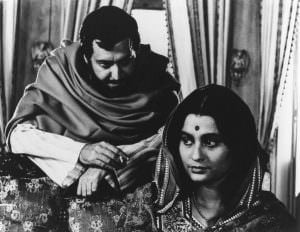
Ghare Baire happens to be one of the most ambitious adaptations of a Tagore novel by Ray. He wanted to adapt this novel into a film in 1947-48 but couldn’t due to some unknown circumstances. But the plot lingered on in his mind. This is one of the most complex works of Tagore as it has a lot of elements. It highlights the hypocrisy of the nationalistic movement and comments about the dichotomy forced upon Indian upper class women. It also largely expresses the disappointment that Tagore experienced as being a part of the movement.
Bimala is initially hesitant to cross the boundaries between the inner courtyard and the outer part of the household, but gradually she gains confidence and crosses the path.
Incorporating all these elements into a film is not easy. That is why many Indian critics felt that this film was over-ambitious. Western critics failed to associate with the film, calling it a very regional and irrelevant for the world audience. But Ray in his screenplay has masterfully woven the question of dichotomy and the hypocrisy of nationalism through the main characters. He has made sure that Bimala remains to be the central character of the narrative. Ray was so passionate about this film that he completed it even after suffering two heart attacks during the filming. Ghare-Baire was nominated for the Palme d’Or at the 1984 Cannes Film Festival.
Ray has focused more on the conversations between the characters than narrating it through the cinematic language. By using symbolism, he carefully builds the image of a Bhadramahila (respectable woman) in Bimala. In the film, we see Bimala, trying out new blouses stitched in the western style. She is taking classes of western music and mannerisms from an English woman. On the other hand, she is cooking and serving her husband. She is also expected to follow the traditional values attached to being a married Hindu woman. Like in one scene, Nikhil asks Bimala to sing a Bangla song and she obediently complies. All that Bimala lives for is to fulfil her husband’s desires.
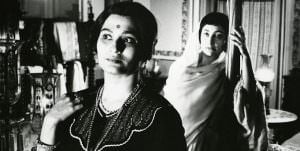
This concept emerged with the nationalist movement which claimed to have solved the woman’s question. Here, in this movement lies the origin of a dichotomy between “the home” and “the world” or “spiritual” and the “material”. “The world” was the outer public life while “the home” was one’s own spiritual self. The nationalist ideology justified this dichotomy by saying that the material world is for male as it demands practicality and deals with business. The spiritual world, which holds India’s superior culture, requires conservation and hence women represent it. This analogy reinstates women’s roles as care-givers for the society.
This dichotomy was a response to the claim by the British that Indian people are “uncivilized” and “barbaric”. This claim was made based on cruel customs like Sati, the societal discrimination against widows and the general illiteracy amongst Indian women. The nationalist movement utilising dichotomy led to a clear construction of social identity and role of gender in the Indian society which was represented by Bimala.
Bimala is the Bhadramahila– who is a learned and sophisticated married woman belonging to the upper caste and upper class. She is as civilized as any British woman. But superior to them because her chastity is protected as she does not socialize with any other men or step out of the antarmahal or the inner courtyard of the household.
Ray depicts the complexity of the dichotomy between the home and the world through Bimala’s responses to the changes taking place in her life. Though educated and obedient, Bimala is not allowed to cross the passage connecting the antarmahal (inner courtyard of the house) to the outer or drawing room. Even in her conversations with Nikhil, she is not willing to cross the boundaries, although he insists. Eventually, she crosses the passage accompanied by her husband, but the move is criticised heavily by society. When she meets Sandip, she is swept away by his passion. But in the end she fails to break the shackles of traditional patriarchy.
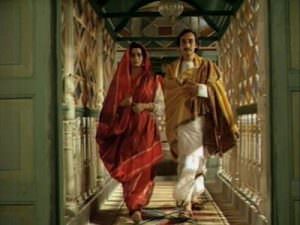
In Ghare-Baire, another supporting yet important character is Bimala’s sister-in-law “Bara Rani“. She is a widow and has no privileges unlike Bimala. In several scenes from the film, she considers Bimala a lucky woman. She also disapproves of the freedom that Bimala receives form her husband, thereby subtly portraying how women internalise misogyny and the patriarchal norms set by the society.
The women servants of the household, belonging to certain lower castes are shown as not wearing upper garments. They are portrayed to have no conversation whatsoever with Nikhil or Bimala. The difference in caste and class is clearly reflected through Ray’s portrayal of such scenes. Through the female characters in the film, Ray exposes the hypocrisy of the nationalistic movement. The portrayal of clothing and mannerisms by Ray brilliantly depicts how the nationalist movement redresses the independence of women from a certain class and caste. Widows and lower caste women remain completely ignored by the nationalist movement.
Another interesting female character in the film is a British woman named Miss Gilby. She teaches western music and mannerisms to Bimala. Ray has not given much screen space to this character but she happens to be Bimala’s connection to the outer world apart from her husband. Also, this character subtly represents the notion that was hammered in the minds of upper class Indians that British women were learned and more civilized than Indian women which is why Bimala was being taught to become westernised woman, and therefore become more civilised.
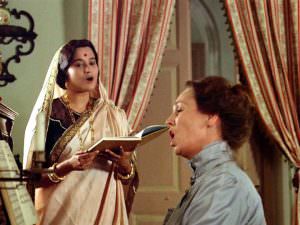
Ghare-Baire, a Bengali classic, remains to be one of the most controversial and widely debated topics amongst film buffs and feminists alike. It is a visual document that depicts the exaggerated emancipation of “certain” women and the forced implementation of the concept of Bhadramahila, thereby showing how women were only to be emancipated because they were an object of possession of men, reflecting the social hierarchy and the position of men.
About the author(s)
Currently pursuing a Master's degree in Women's and Gender Studies. I am an entrepreneur and a freelance writer. Interested in pursuing real stories, social issues and women's issues.
